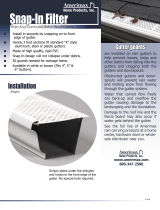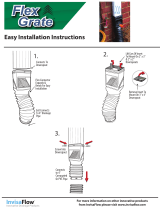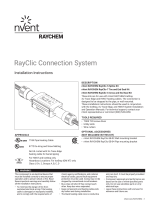Page is loading ...

Installation and Operation Manual for
Roof and Gutter De-icing Systems
IceStop System

ii | nVent.com
Important Safeguards and Warnings
WARNING: FIRE AND SHOCK HAZARD.
nVent RAYCHEM IceStop must be installed correctly to
ensure proper operation and to prevent shock and fire.
Read these important warnings and carefully follow all
the installation instructions.
• To minimize the risk of fire from sustained electrical
arcing if the heating cable is damaged or improperly
installed and to comply with nVent requirements,
agency certifications, and national electrical codes,
ground-fault equipment protection must be used on
each heating cable branch circuit. Arcing may not be
stopped by conventional circuit breakers.
• Approvals and performance are based on the use of
nVent RAYCHEM parts only. Do not substitute parts
or use vinyl electrical tape.
• Bus wires will short if they contact each other. Keep
bus wires separated.
• Connection kits and cable ends must be kept dry
before and during installation.
• The black heating cable core and fibers are
conductive and can short. They must be properly
insulated and kept dry.
• Damaged bus wires can overheat or short. Do not
break bus wire strands when scoring the jacket or
core.
• Damaged heating cable or connection kits can cause
electrical shock, arcing or fire. Do not attempt to repair
or energize damaged cable. Remove damaged sections
at once and replace them with a new length using
the appropriate nVent RAYCHEM splice kit. Replace
damaged connection kits.
• To minimize the risk of fire, heating cable must
only be used for de-icing. Heating cable must not
be installed inside buildings. All heating cable to
junction box or power cable connections must be
made external to the building. For connection to
the power supply, an appropriately-sized power
cable must be used with proper power connection
accessories.

nVent.com | iii
Table of Contents
1
General Information 1
1.1 Use of the Manual 1
1.2 IceStop Applications 1
1.3 Safety Guidelines 2
1.4 Typical Roof and Gutter System 3
1.5 Approvals 6
1.6 Warranty 6
2
Pre-Installation Checks 7
2.1 Check Materials 7
2.2 Connection Kits and Accessories 8
2.3 Review the Design 12
3
Heating Cable Installation 13
3.1 Heating Cable Handling 13
3.2 Protecting the Heating Cable 14
3.3 Visual Inspection 14
3.4 Heating Cable Layout 15
4
Attachment Methods 30
4.1 Overview 30
4.2 Roof Attachment Methods 31
4.3 Attachment Methods for Other Areas 36
5
Control, Monitoring and Power Distribution 40
5.1 Control Systems 40
5.2 Power Distribution 45
6
Commissioning and Preventive Maintenance 49
6.1 System Start-up and Operation 49
6.2 Insulation Resistance (Megohmmeter) Test 49
6.3 Continuity Test 52
7
Test Procedures 53
7.1 Tests 53
7.2 Insulation Resistance Test – Test 1 54
7.3 Insulation Resistance (Megohmmeter) Test 55
7.4 Fault Location Tests 58
8
Troubleshooting Guide 62
9
Installation and Inspection Records 68

iv | nVent.com

nVent.com | 1
General Information
1
1.1 Use of the Manual
This manual covers the installation of nVent
RAYCHEM IceStop roof and gutter de-icing
system. The manual covers general heating
cable installation procedures and specific
installation details and shows available
connection kits. The manual also discusses
controls, testing, and periodic maintenance.
This manual assumes that the proper roof and
gutter de-icing design has been completed
according to the Roof and Gutter De-Icing:
IceStop System Design Guide (H56070).
Only the applications described in Section1.2
are approved by nVent for IceStop systems
when used with approved nVent RAYCHEM
connection kits. The instructions in this manual
and the installation instructions included with
the connection kits must be followed for the
nVent warranty to apply. Contact your nVent
representative for other applications and
products.
1.2 IceStop Applications
IceStop is a roof and gutter de-icing system that
provides drain paths for the following
applications:
• Roofs made from standard roofing materials,
including shake, shingle, rubber, tar, wood,
metal, and plastic.
• Gutters made from standard materials,
including metal, plastic, and wood.
• Downspouts made from standard materials,
including metal and plastic.
The guide does not provide information for using
an IceStop system for the following applications:
• Preventing snow movement on roofs—IceStop
will not keep snow or ice from falling off
the roof. IceStop is designed to remove melt
water, not accumulated snow. Snow fences or
snow guards should be used to eliminate snow
movement.

2 | nVent.com
For the names of manufacturers of snow
guards or snow fences, contact your nVent
representative, or contact us directly at
(800)545-6258.
• Melting snow on a roof and/or reduction of
snow load—IceStop is designed to remove
melt water, not accumulated snow.
If your application conditions are different,
or if you have any questions, contact:
nVent
7433 Harwin Drive
Houston, TX 77036
USA
Tel: +1.800.545.6258
Fax: +1.800.527.5703
nVent.com
1.3 Safety Guidelines
The safety and reliability of any heat-tracing
system depends on the quality of the products
selected and the manner in which they are
installed and maintained. Incorrect design,
handling, installation, or maintenance of any
of the system connection kits could damage
the de-icing system or the roof and may
result in inadequate de-icing, electric shock,
or fire. To minimize these risks and to ensure
that the system performs reliably, read and
carefully follow the information, warnings, and
instructions in this guide.
• Important instructions are marked Important
• Warnings are marked WARNING
General Information
1

nVent.com | 3
1.4 Typical Roof and Gutter System
Ice dams can cause water ingress into buildings
and generate dangerous icicles. An IceStop
system can help prevent ice dams and icicles
by maintaining a continuous path for melt water
to drain from the roof. As long as a heated
path from the roof to a safe discharge area is
maintained, ice dams will not form. The IceStop
system can be used on roofs and valleys and
in downspouts and gutters made from all types
of standard roofing materials, including metal,
plastic, wood, shake/shingle, rubber, and tar.
The IceStop system is intended to provide drain
paths. A typical system is shown in Figure 1.
General Information
1

4 | nVent.com
Power Connection Kits Splice Kits
Attachment Kits Tee Kits
Gutter Sensor
Downspout Hanger Kit End Seal Kit
Heating Cable
Lighted End Seal
Power Distribution Panel
APS-4
SUPPLY
SNOW
HEATER
GROUND FAULT
GROUND FAULT
HEATER CYCLE
RESET
TEST
HOLD ON TIME (HRS)
Snow/Ice Melting Controller
SUPPLY : 277 VAC, 50/60HZZ, 35VA
HEATER: 377 VAC, 40 AMP. MAX RESIS
USE ONLY COPPER CONDUCTORS HAVING
SUFFICIENT AMPACITY.
SEE INSTALLATION INSTRUCTIONS
WARNING
DANGER OF ELECTRICAL SHOCK OR ELCTROCUTION
Lethal voltages are present beneath this cover. Servicee by
qualified personnel only. More than one disconnect may be
required to de-energize this control for servicing.
Snow Controller
Figure 1: IceStop Roof and Gutter De-Icing System
General Information
1

nVent.com | 5
Power Connection Kits Splice Kits
Attachment Kits Tee Kits
Gutter Sensor
Downspout Hanger Kit End Seal Kit
Heating Cable
Lighted End Seal
Power Distribution Panel
APS-4
SUPPLY
SNOW
HEATER
GROUND FAULT
GROUND FAULT
HEATER CYCLE
RESET
TEST
HOLD ON TIME (HRS)
Snow/Ice Melting Controller
SUPPLY : 277 VAC, 50/60HZZ, 35VA
HEATER: 377 VAC, 40 AMP. MAX RESIS
USE ONLY COPPER CONDUCTORS HAVING
SUFFICIENT AMPACITY.
SEE INSTALLATION INSTRUCTIONS
WARNING
DANGER OF ELECTRICAL SHOCK OR ELCTROCUTION
Lethal voltages are present beneath this cover. Servicee by
qualified personnel only. More than one disconnect may be
required to de-energize this control for servicing.
Snow Controller
Figure 1: IceStop Roof and Gutter De-Icing System
General Information
1

6 | nVent.com
1.5 Approvals
The IceStop roof and gutter de-icing system is
UL Listed, CSA Certified, and FM Approved for
use in nonhazardous areas. nVent RAYCHEM
GM-1XT and GM-2XT are also FM Approved for
use in Class I, Division 2 hazardous locations.
1.6 Warranty
nVent limited standard warranty applies to all
products. You can access the complete warranty
at nVent.com. To qualify for an extended 10-year
warranty, register online within 30 days of
installation at https://raychem.nvent.com/
en-us/support/warranty-information
General Information
1

nVent.com | 7
Pre-Installation Checks
2
2.1 Check Materials
If physical damage is found, the entire damaged
section must be removed and a new section of
heating cable spliced in, using only approved
nVent RAYCHEM splice kits. Do not attempt to
repair the damaged heating cable section. If the
damage cannot be found, the complete circuit
should be removed and replaced with new
IceStop heating cable.
WARNING: Shock or Fire Hazard. Damaged
heating cable or connection kits can cause
electrical shock, arcing, and fire. Do no attempt
to energize damaged heating cable or connection
kits. Replace them immediately using a new
length of heating cable and the appropriate
IceStop accessories.
Important: All heating cable to junction
box or power cable connections must be made
external to the building. The heating cable
must not be installed inside the building. For
connection to the power source, correctly sized
power source wiring must be used.
Catalog number: GM — 1 or 2 XT or X
Product family
Voltage 1 = 120 V
2 = 208-277 V
Jacket type: Fluoropolymer
Polyolefin
or
Figure 2: Catalog number

8 | nVent.com
Pre-Installation Checks
2
2.2 Connection Kits and Accessories
TABLE 1:
NVENT RAYCHEM CONNECTION KITS
Catalog number
Description
Heating
cable
allowance
1
Power connection
RayClic-PC
Quick connect power
connection kit to power
1 run of heating cable.
Includes 1 end seal.
Standard pkg: 1
2 ft (0.6 m)
RayClic-PS
Quick connect power
connection kit to power
2 runs of heating cable.
Includes 2 end seals.
Standard pkg: 1
2 ft (0.6 m)
RayClic-PT
Quick connect power
connection kit to power
3 runs of heating cable.
Includes 3 end seals.
Standard pkg: 1
3 ft (1 m)
RayClic-LE
Alternate lighted end seal
Standard pkg: 1
2 ft (0.6 m)
R
RayClic-X
Cross connection to
connect four heating
cables
Standard pkg: 1
8 ft (2.4 m)
End seal
RayClic-E
Extra end seal
Standard pkg: 1
0.3 ft (0.1 m)
Important: With the exception of RayClic-PC, power
source wiring for connection to power source not included
with power connection kits.

nVent.com | 9
Pre-Installation Checks
2
TABLE 1:
NVENT RAYCHEM CONNECTION KITS
Catalog number
Description
Heating
cable
allowance
1
Junction box
FTC-P
Junction box
1
mounted
HSP power connection kit.
Includes 1 end seal.
Standard pkg: 1
2 ft (0.6 m)
Splice connection
RayClic-S
Quick connect splice kit
Standard pkg: 1
2 ft (0.6 m)
FTC-HST
Heat-shrinkable splice kit
Standard pkg: 2
2 ft (0.6 m)
Tee connection
RayClic-T
Quick connect tee kit
Standard pkg: 1
2 ft (0.6 m)
FTC-HST
2
Heat-shrinkable tee kit
Standard pkg: 2
2 ft (0.6 m)
1
Junction box not included.
2
One RayClic-E end seal is required for each FTC-HST
used as a tee kit.
Important: With the exception of RayClic-PC, power
source wiring for connection to power source not included
with power connection kits.

10 | nVent.com
TABLE 2:
NVENT RAYCHEM ATTACHMENT ACCESSORIES
Catalog number Description
No. of packages
required
Mounting bracket
RayClic-SB-02
RayClic wall
mounting
bracket
Standard pkg: 1
1 mounting bracket/
RayClic connec-
tion kit (except
RayClic-E) installed
on a wall
GMK-RC
Mechanical
(penetrating)
roof clip
Standard pkg: 50
1 box per 35' of roof
edge when zig-zag
layout is used
GM-RAKE
Hanger bracket
Standard pkg: 1
1 hanger per cable
in downspout
or as required
for mechanical
protection
CT-CABLE-TIE UV-resistant
cable tie
Standard pkg: 100
Varies depending on
installation
Pre-Installation Checks
2

nVent.com | 11
Adhesives for Metal Roofs
With the adhesives that are available today, the
attachment of clips to metal roofs can be as
reliable as screws or nails into a wooden roof.
The adhesives that perform the best allow some
flexibility in the connection between the clip and
the roof surface. Adhesives such as epoxies,
which cure to a hard nonflexible form, should
not be used. Acid-curing silicones, which are
not as strong and could damage the roof, also
should not be used.
The adhesives listed below have been
evaluatedby nVent.
TABLE 3: ADHESIVES FOR METAL ROOFS
Adhesive Description Times
Dispensing
equipment
Momentive
Performance
Materials, Inc.
RTV167
Neutral-cure
silicone
adhesive
Tooling
20 min
Cure
48 hr
Caulking gun
SpeedBonder
H4800
Methacrylate
adhesive
Tooling
45–55 min
Cure
24 hr
Two-part
mixing
dispenser
Plexus MA300 Methacrylate
adhesive
Tooling
15 min
Cure
16 hr
Two-part
mixing
dispenser
Plexus MA310 Methacrylate
adhesive
Tooling
30 min
Cure
16 hr
Two-part
mixing
dispenser
Important
: Adhesive is not supplied by nVent. Contact
the manufacturers listed for information on local distributors.
Follow manufacturer’s instructions for surface preparation and
installation.
Pre-Installation Checks
2

12 | nVent.com
Tooling time is the maximum amount of time the
product is usable after being mixed. Cure time is the
waiting time required before installing heating cable.
Momentive Performance Materials, Inc. RTV 167
Silicone Adhesive
is a neutral-cure silicone
adhesive. Contact: (800) 332-3390.
SpeedBonder H3300 and H4800 are general
purpose, two-component, room-temperature
curing, 1:1 mix ratio, methacrylate adhesive
systems. Contact: (800) 767-8786.
Plexus MA310 and MA300 are two-component
methacrylate adhesives designed for structural
bonding of thermoplastic, metal, and composite
assemblies. Contact: (800) 851-6692.
Please consult with a roofing contractor before
purchasing and installing clips with the adhesives.
It is extremely important to follow the adhesive
manufacturer’s instructions carefully, especially
with regard to surface preparation.
2.3 Review the Design
Hold a project coordination meeting. Review
the design at this meeting and ensure that the
cables supplied meet the design requirements.
Plan the location of all junction boxes and supply
points. Review the installation steps in Section
3 for the particular application as several trades
may be involved in the system installation. Review
Section 4 on attachment methods. During the
meeting, discuss the role of each trade and the
contractor.
Pre-Installation Checks
2

nVent.com | 13
Heating Cable Installation
3
3.1 Heating Cable Handling
Paying Out the Cable
Mount the reel on a holder and place it near
either end of the roof area to be heated. Use
a reel holder that pays out smoothly with little
tension. Avoid jerking the cable while pulling.
When paying out the heating cable, AVOID:
• Sharp edges
• Excessive pulling force or jerking
• Kinking or crushing
• Walking on or running over the heating cable
with equipment
Connection Kits and Accessories Installation
Start by installing connection kits and
accessories in locations indicated on project
drawings or as indicated in “Heating Cable
Layout” beginning on the following page.
Once all clips and downspout hangers are in
place, and adhesives cured if applicable, the
heating cable can be installed.
Start at the end seal and work back. Be sure
to leave a drip loop at connection kits so that
water will not track down the heating cable into
the component. Install heating cable using the
sample layout shown in “Heating Cable Layout”
on page 15.
• Be sure the heating cable provides a
continuous path for water to flow off the roof.
• Be sure to leave drip loops where appropriate.
• Do not exceed maximum circuit length
determined during design process using the
Roof and Gutter De-Icing: IceStop System
Design Guide (H56070).
• Be sure to loop and secure heating cable at
the bottom of downspouts so that the heating
cable is not exposed to mechanical damage.
• Install a UV-resistant cable tie wherever two
heating cables are intended to stay together.

14 | nVent.com
• Test installed heating cable for insulation
resistance and continuity (see “Procedure” on
page56).
3.2 Protecting the Heating Cable
On many projects, there is a delay between
installation of the heating cables and installation
of heating system connection kits. If this is the
case, take the following precautions to protect
the heating cables and components.
• Keep covers on junction boxes to prevent
moisture from entering them.
• Mechanically protect the heating cables so
that they cannot be damaged by being walked
on, run over, painted, sandblasted, burned,
welded, or cut.
• Do not allow ends of heating cable to be
exposed to moisture.
3.3 Visual Inspection
A visual inspection of the IceStop system
should be made after installation is complete.
This inspection will ensure:
• Proper installation of the system
• No mechanical damage (cuts, burns, scrapes,
etc.) to cable sustained during installation
• Proper heating cable width and height
• Proper heating cable fastening
Further visual inspection of the IceStop system
is recommended following any further work
performed on building that may cause damage
to the system. Further work may include, but
is not limited to, roofing, gutter or downspout
maintenance or repair, manual snow removal,
installation of mechanical, electrical or
communications equipment such as antennas,
receivers, or air conditioning units. Also, if
roof sustains damage of any kind, visual and
functional inspection of IceStop system is
recommended.
Heating Cable Installation
3

nVent.com | 15
3.4 Heating Cable Layout
Heating cable layout depends primarily on
the roof type and roof features. The following
sections show typical layouts on standard roof
types:
• “Sloped Roof – Standard” on page16
• “Sloped Roof – Standing Seam” on page18
• “Flat Roof” on page20
• “Sloped Roof without Gutters” on page21
• “Roof Valleys” on page23
• “Roof/Wall Intersections” on page24
• “Gutters” on page25
• “Downspouts” on page28
Important
: For optimum performance, the
heating cable should be in contact with snow or
ice. Installing the heating cable under the roofing
or the roofing materials will reduce the efficiency
of the heating system. Please contact nVent for
assistance.
Figure 3 and Figure 4 following illustrate several
important terms:
Tracing
width
Tracing
height
Clips
Downspout
hanger
Figure 3: Front view of roof with IceStop system
Heating Cable Installation
3

16 | nVent.com
12" (30 cm)
Area where ice dams are
most likely to form
Eave overhang
Exterior wall
Heating cable
Gutter
Roof
Heated
area
Figure 4: Side view of roof with IceStop system
Sloped Roof – Standard
For sloped roofs, ice dams may form at the
roof edge. To maintain a continuous path for
melt water runoff, route the heating cable in a
zig-zag pattern as shown in Figure 5 and follow
the appropriate attachment recommendations
in “Attachment Methods”, page30. Additional
heating cable may be needed for other gutters,
downspouts, and valleys.
2' (60 cm)
Figure 5: Layout in a zig-zag pattern
• Run heating cable up the roof until it is
12inches (30 cm) past the exterior wall into
the heated area (see Figure 4).
• Install the heating cable on the roof in a
zig-zag pattern as shown in Figure 5.
Heating Cable Installation
3
/






